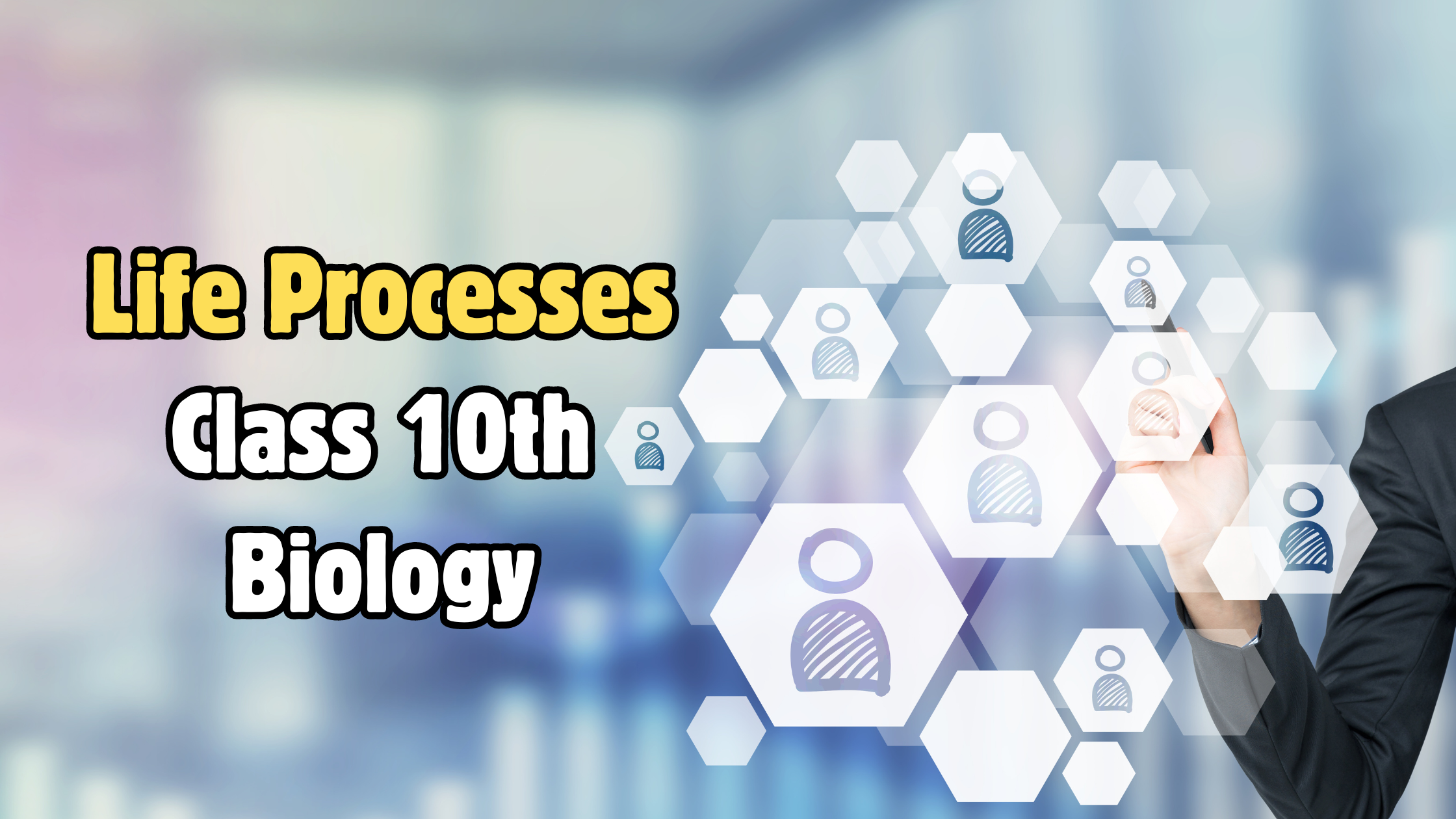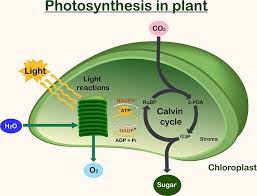We are sharing the NCERT solutions of class 10th Biology chapter Life Processes with you along with some important diagrams to help you all with the important notes of the Life Processes chapter.
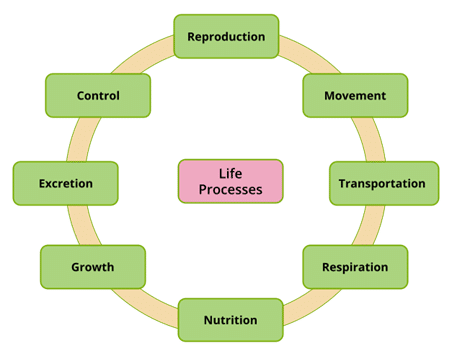
Life Processes: NCERT Solutions Class 10th
Q1. The kidneys in human beings are a part of the system for
(a) nutrition.
(b) respiration.
(c) excretion.
(d) transportation.
Answer 1:
(c) In human beings, the kidneys are a part of the system for excretion.
Q2. The xylem in plants is responsible for
(a) the transport of water.
(b) transport of food.
(c) transport of amino acids.
(d) transport of oxygen.
Answer 2:
(a) In a plant, the xylem is responsible for the transport of water.
Q3. The autotrophic mode of nutrition requires
(a) carbon dioxide and water.
(b) chlorophyll.
(c) sunlight.
(d) all of the above.
Answer 3:
(d) The autotrophic mode of nutrition requires carbon dioxide, water, chlorophyll
and sunlight.
Q4. The breakdown of pyruvate to give carbon dioxide, water, and energy takes place in
(a) cytoplasm.
(b) mitochondria.
(c) chloroplast.
(d) nucleus.
Answer 4:
(b) The breakdown of pyruvate to give carbon dioxide, water, and energy takes
place in mitochondria.
Q5. How are fats digested in our bodies? Where does this process take place?
Fats are present in the form of large globules in the small intestine. The small intestine gets the secretions in the form of bile juice and pancreatic juice respectively from the liver and the pancreas. The bile salts (from the liver) break down the large fat globules into smaller globules so that the pancreatic enzymes can easily act on them. This is referred to as emulsification of fats. It takes place in the small intestine.
Q6. What is the role of saliva in the digestion of food?
Saliva is secreted by the salivary glands, located under the tongue. It makes the food soft for easy swallowing. It contains a digestive enzyme called salivary amylase, which breaks down starch into sugar.
Q7. What are the necessary conditions for autotrophic nutrition and what are its by-products?
Autotrophic nutrition takes place through the process of photosynthesis. Carbon dioxide, water, chlorophyll pigment, and sunlight are the necessary conditions required for autotrophic nutrition. Carbohydrates (food) and O2 are the by-products of photosynthesis.
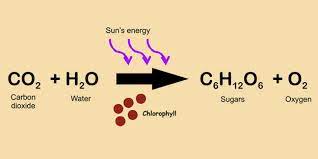
Q8. How are the alveoli designed to maximize the exchange of gases?
The alveoli are the small balloon-like structures present in the lungs. The walls of the alveoli consist of an extensive network of blood vessels. Each lung contains 300−350 million alveoli, making it a total of approximately 700 million in both lungs. The alveolar surface when spread out covers about 80 m2 area. This large surface area makes the gaseous exchange more efficient.
Q9. What would be the consequences of a deficiency of hemoglobin in our bodies?
Hemoglobin is the respiratory pigment that transports oxygen to the body cells for cellular respiration. Therefore, deficiency of hemoglobin in the blood can affect the oxygen supplying capacity of the blood. This can lead to a deficiency of oxygen in the body cells. It can also lead to a disease called anemia.
Q10. Describe double circulation in human beings. Why is it necessary?
Because both oxygen and carbon dioxide have to be transported by the blood, the heart has different chambers to prevent the oxygen-rich blood from mixing with the blood containing carbon dioxide. The human heart is divided into four chambers − the right atrium, the right ventricle, the left atrium, and the left ventricle. Oxygen-rich blood from the lungs comes to the thin-walled upper chamber of the heart on the left, the left atrium. The left atrium relaxes when it is collecting this blood. It then contracts, while the next chamber, the left ventricle, expands, so that the blood is transfered.
Double Circulation is necessary:
The separation of oxygenated and de-oxygenated blood allows a more efficient supply of oxygen to the body cells. This efficient system of oxygen supply is very useful in warm-blooded animals such as human beings. As we know, warm-blooded animals have to maintain a constant body temperature by cooling themselves when they are in a hotter environment and by warming their bodies when they are in a cooler environment.
Hence, they require more O2 for more respiration so that they can produce more energy to maintain their body temperature. Thus, the circulatory system of humans is more efficient because of the double circulatory heart transferred to it. When the muscular left ventricle contracts in its turn, the blood is pumped out to the body. De-oxygenated blood comes from the body to the upper chamber on the right, the right atrium, as it expands. As the right atrium contracts, the corresponding lower chamber, the right ventricle, dilates. This transfers blood to the right ventricle, which in turn pumps it to the lungs for oxygenation. During this process, blood goes twice through the heart. That’s why it is known as double circulation.
Q11. Why is diffusion insufficient to meet the oxygen requirements of multicellular organisms like humans?
In multi-cellular organisms, all the cells may not be in direct contact with the surrounding environment. Thus, simple diffusion will not meet the requirements of all the cells.
Q12. What criteria do we use to decide whether something is alive?
Any visible movement such as walking, breathing, or growing is generally used to decide whether something is alive or not. However, a living organism can also have movements, which are not visible to the naked eye. Therefore, the presence of molecular movement inside the organisms is used to decide whether something is alive or not.
Q13. What are outside raw materials used by an organism?
An organism uses outside raw materials mostly in the form of food (Since life on earth depends on carbon-based molecules, most of these food sources are also carbon-based) and oxygen. The raw materials required by an organism can be quite varied depending on the complexity of the organism and its environment.
Q14. Where do plants get each of the raw materials required for photosynthesis?
The following raw materials are required for photosynthesis:
- The raw material CO2 enters the atmosphere through stomata.
- Water is absorbed from the soil by the plant roots.
- Sunlight, an important component to manufacture food, is absorbed by the
- chlorophyll and other green parts of the plants.
Q15. What is the role of the acid in our stomach?
- Role of the acid (HCl) in our stomach:
- Kills germs present in the food.
- Makes the food acidic, so that pepsin can digest protein.
Q16. What is the function of digestive enzymes?
Digestive enzymes such as amylase, lipase, pepsin, trypsin, etc. help in the breaking down of complex food particles into simple ones. These simple particles can be easily absorbed by the blood and thus transported to all the cells of the body.
Q17. How is the small intestine designed to absorb digested food?
The small intestine has millions of tiny finger-like projections called villi. These villi increase the surface area for food absorption. Within these villi, many blood vessels are present that absorb the digested food and carry it to the bloodstream. From the bloodstream, the absorbed food is delivered to each and every cell of the body.
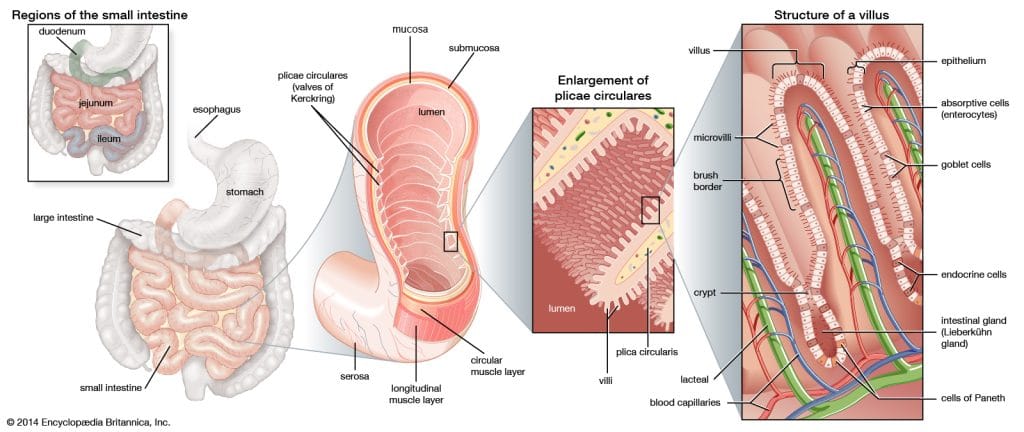
Q18. What advantage over an aquatic organism does a terrestrial organism have with regard to obtaining oxygen for respiration?
Since the amount of dissolved oxygen is fairly low compared to the amount of oxygen in the air, the rate of breathing in aquatic organisms is much faster than that seen in terrestrial organisms. Therefore, unlike aquatic animals, terrestrial animals do not have to show various adaptations for better gaseous exchange.
Q19. What are the different ways in which glucose is oxidized to provide energy in various organisms?
Glucose is first broken down in the cell cytoplasm into a three-carbon molecule called pyruvate. Pyruvate is further broken down in the following ways to provide Energy.
Q20. How are oxygen and carbon dioxide transported in human beings?
Hemoglobin transports oxygen molecules to all the body cells for cellular respiration. The hemoglobin pigment present in the blood gets attached to O2 molecules that are obtained from breathing.
It thus forms oxyhemoglobin and the blood becomes oxygenated. This oxygenated blood is then distributed to all the body cells by the heart. After giving away O2 to the body cells, blood takes CO2 which is the end product of cellular respiration. Now the blood becomes de-
Oxygenated. Since hemoglobin pigment has less affinity for CO2, CO2 is mainly transported in the dissolved form. This de-oxygenated blood gives CO2 to lung alveoli and takes O2 in return.
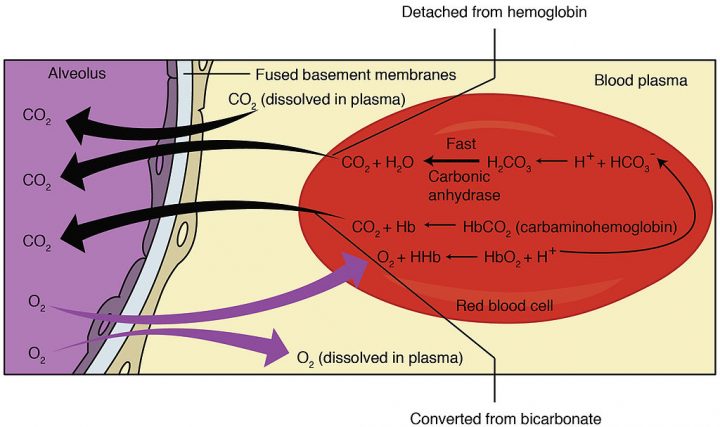
Q21. How are the lungs designed in human beings to maximize the area for the exchange of gases?
The exchange of gases takes place between the blood capillaries that surround the alveoli and the gases present in the alveoli. Thus, alveoli are the site for an exchange of gases. The lungs get filled up with air during the process of inhalation as ribs are lifted up and the diaphragm is flattened. The air that is rushed inside the lungs fills the numerous alveoli present in the lungs. Each lung contains 300-350 million alveoli. These numerous alveoli increase the surface area for gaseous exchange making the process of respiration more efficient.
 Q22. What are the components of the transport system in human beings? What are the functions of these components?
Q22. What are the components of the transport system in human beings? What are the functions of these components?
- The main components of the transport system in human beings are the heart, blood, and blood vessels.
- The heart pumps oxygenated blood throughout the body. It receives deoxygenated blood from the various body parts and sends this impure blood to the lungs for oxygenation.
- Blood is a fluid connective tissue, it helps in the transport of oxygen, nutrients, CO2, and nitrogenous wastes. Blood vessels (arteries, veins, and capillaries) carry blood either away from the heart to various organs or from various organs back to the heart.
Q23. Why is it necessary to separate oxygenated and deoxygenated blood in mammals and birds?
Warm-blooded animals such as birds and mammals maintain a constant body temperature by cooling themselves when they are in a hotter environment and by warming their bodies when they are in a cooler environment. Hence, these animals require more oxygen (O2) for more cellular respiration so that they can produce more energy to maintain their body temperature.
Thus, it is necessary for them to separate oxygenated and de-oxygenated blood, so that their circulatory system is more efficient and can maintain their constant body temperature.
Q24. How are water and minerals transported in plants?
The components of xylem tissue (tracheids and vessels) of roots, stems, and leaves are interconnected to form a continuous system of water-conducting channels that reaches all parts of the plant. Transpiration creates a suction pressure, as a result of which water is forced into the xylem cells of the roots. Then there is a steady movement of water from the root xylem to all the plant parts through the interconnected water-conducting channels.

Q25. How is food transported in plants?
Phloem transports food materials from the leaves to different parts of the plant body. The transportation of food in phloem is achieved by utilizing energy from ATP. As a result of this, the osmotic pressure in the tissue increases causing water to move into it. This pressure moves the material in the phloem to the tissues which have less pressure. This is helpful in moving materials according to the needs of the plant. For example, the food material, such as sucrose, is transported into the phloem tissue using ATP energy.
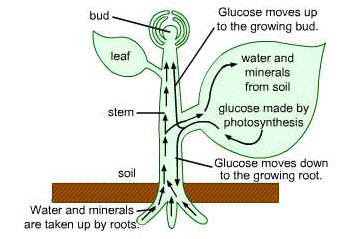
Q26. Describe the structure and functioning of nephrons.
Nephrons are the basic filtering units of kidneys. Each kidney possesses a large number of nephrons, approximately 1-1.5 million. The main components of the nephron are the glomerulus, Bowman’s capsule, and a long renal tubule.
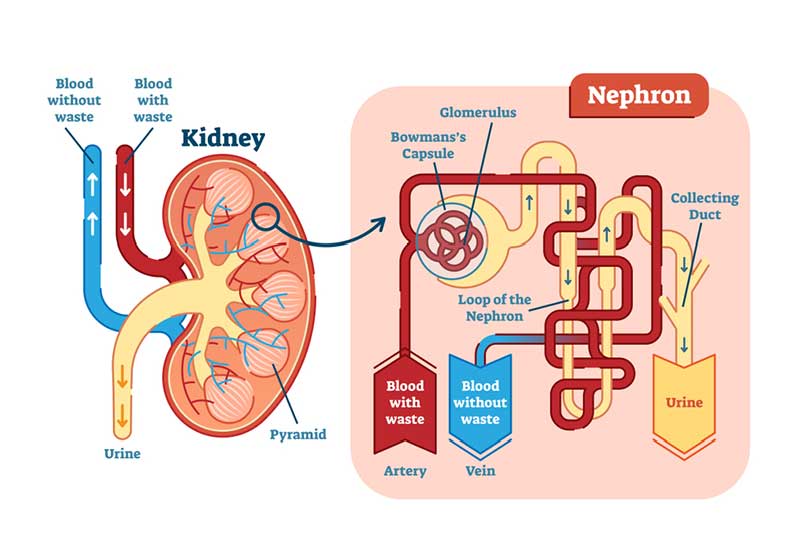 Functioning of a nephron:
Functioning of a nephron:
- The blood enters the kidney through the renal artery, which branches into many capillaries associated with the glomerulus.
- The water and solute are transferred to the nephron at Bowman’s capsule. In the proximal tubule, some substances such as amino acids, glucose, and salts are selectively reabsorbed and unwanted molecules are added to the urine.
- The filtrate then moves down into the loop of Henle, where more water is absorbed.
- From here, the filtrate moves upwards into the distal tubule and finally to the collecting duct. The collecting duct collects urine from many nephrons.
- The urine formed in each kidney enters a long tube called a ureter. From the ureter, it gets transported to the urinary bladder and then into the urethra.
Q27. What are the methods used by plants to get rid of excretory products?
Plants use completely different strategies for excretion than those of animals. They can get rid of excess water by transpiration. For other wastes, plants use the fact that many of their tissues consist of dead cells, and that they can even lose some parts such as leaves. Many plant waste products are stored in cellular vacuoles. Waste products may be stored in leaves that fall off. Other waste products are stored as resins and gums, especially in old xylem. Plants also excrete some waste substances into the soil around them.
Q28. How is the amount of urine produced regulated?
The amount of urine produced depends on the amount of excess water and dissolved wastes present in the body. Some other factors such as the habitat of an organism and hormone such as Antidiuretic hormone (ADH) also regulates the amount of urine produced.
Conclusion
We have provided you with the NCERT Solutions of class 10th Biology Chapter Life Processes along with the important diagrams and necessary equations to help the students to be ready with the basic exercises.
Related Articles
NCERT Solutions for Class 9 Science
NCERT Solutions for Class 9 Science Chapter 12 Sound
Drainage Class 9th NCERT Solutions Geography

